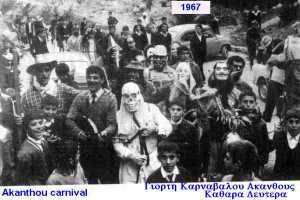


|
|
|
|
|||

|
|||||

|

|
||||
|
|
|
|
|
|
|
|
|
|
|
|
|
|
|
|
|
||||
|
|
|
|
|||||||||||||||||
|
|
|||||||||||||||||||
|
|
|||||||||||||||||||

|
|||||||||||||||||||
|
|
|||||||||||||||||||
|
Every visitor to Akanthou when entering the village was welcome by some cylinder shaped holes in the ground on the hillside of “Mandri”(
Mantri
) and which some of these holes were covered by round flat stones.
It is well known that the wheat is prone to catching a decease. This disease was in the form of insects eating the inside of the wheat and the Akanthiotes to avoid this disease they would store the wheat in these Vouhes. Before the wheat was placed in the Vouhes, they had to be prepared first. The villagers would burn out the inside of the Vouhes for a period of about 4-5 days so that every disease was destroyed.
|
|||||||||||||||||||
|
|
|||||||||||||||||||
|
|
|
|
|
|
|
|
|
i) According to the old calendar, on the day that Ayios Platonas Ayios Romanos celebrate 18th November if the weather front is coming from the north eastern direction then it will not rain for 40 days. ii) If the sea makes a roaring sound then heavy rain will follow in 24 hours. iii) When there is a little ring around the moon then it will rain and when there’s a large ring that is an indication of strong winds. iv) At sun rise if there is a belt in front of the sun then it will rain in 24 hours. v) When there is thunder and lighting and the lighting is very clear and occurring in the south then it will be very windy coming from a northern direction. vi) When there is thunder and lighting and the lighting is not very clear ( you can just about see it) this means that it will rain very heavily in 3 days the latest.
|
|
|
|
|
|
|
|
|
|
|
|
|
|
|
||||||||||
|
Candle lit graves
|
||||||||||
|
|
||||||||||
|
The burning of Judas
The youngsters will then, using special guns ( pistoles ) filled with gunpowder will start shooting at Judas. This was very dangerous and every year there were accidents. When everyone’s had a go shooting at him, he will then be taken to the end of the church yard and blown up. The explosion was so great , Judas will shoot very high in the air passing the church bell-towers. |
||||||||||
|
|
||||||||||